By
Donald H. Harrison
(Enter the park by proceeding from the corner of
Sixth and Laurel across the Cabrillo Bridge spanning the freeway.
The formal entryway to the park on the east side of the bridge is where
our tour begins.)
In 1867, Joseph Mannasse, one of San Diego's original Jewish settlers,
was a member of the city Board of Trustees which decided some city land
ought to be set aside for a large park. The trustees voted to authorize
creation of a committee to search out just the right spot.
The committee reported back the following year, but by that time Mannasse's
one-year term on the Board of Trustees was over. However, his friend and
brother-in-law, Marcus Schiller, had taken his place on the three-member
board. Schiller voted in 1868 to put aside the land that became Balboa
Park.
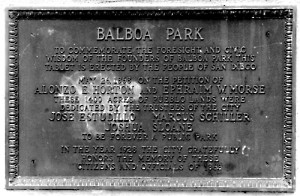 |
A plaque commemorating Schiller and other trustees for
their foresight can be found today in the plaza on the southwestern side
of the entryway to Balboa Park.
On top of the structure, looking down on the traffic, are two figures
representing the Atlantic and Pacific Oceans. Where their fingers touch
symbolically represents the Panama
Canal.
In 1909, the leadership of the City of San |
|
Plaque honoring Marcus Schiller
|
Diego was quite excited about the construction of the Panama Canal. They
knew that when the canal was finished, San Diego would become the first
U.S. port north of the canal on the West Coast. If people could only be
made aware of how beautiful a place San Diego was, perhaps the railroads
could be persuaded to make San Diego a western terminus for a transcontinental
railroad! In such a case, San Diego could become a leading entrepot of
the world.
With such visions in their eyes, a committee was organized to stage
the Panama-California Exposition in 1915, the year the Canal was scheduled
to open, as a way of publicizing San Diego's potential. Among the committee's
board of directors were three prominent members of the Jewish community:
Julius Wangenheim, Simon Levi and L.A. Blochman.
Up till nearly the opening, the park was known simply as City Park,
a name considered hardly grand enough for such an important enterprise.
So a contest was held, and the winning suggestion for a name was Balboa
Park -- after the Spanish explorer Vasco Nunez de Balboa, who in 1513 became
the first European explorer to cross the Isthmus of Panama from the Atlantic
Ocean to the Pacific Ocean.
Balboa never laid eyes on San Diego. He died in 1519, and San Diego
was not "discovered" by a European explorer until 1542, when Juan Rodriguez
Cabrillo, a Portuguese-born sailor, claimed it for Spain. Of course, the
Kumeyaay Indians who had lived in San Diego since prehistoric times had
discovered San Diego far earlier. Nevertheless, Cabrillo is remembered
with the bridge leading to Balboa Park. Additionally, that section of Highway
163 going under the bridge is officially named the Cabrillo Freeway.
As it turned out, the railroads decided that Los Angeles, rather than
San Diego, would make a better terminal for a transcontinental line, owing
in no small measure to the rugged topography east of San Diego. Thus Los
Angeles, which up to then had been a rather small town up the coast from
San Diego, was destined to become a major metropolitan area of California.
Although San Diego did not become the great trading center it had hoped
to be, the buildings constructed for the Exposition created the nucleus
of a park that today has one of the greatest collections of museums anywhere
and in one of the world's most agreeable settings. More buildings were
added in 1935 when the state held the California-Pacific Exposition.
Some of the structures that remain from the 1915 exposition are the
California Building, today home to the Museum of Man; the Organ Pavilion
which was donated by the Spreckels sugar family, the Cabrillo Bridge and
the Botanical Building.
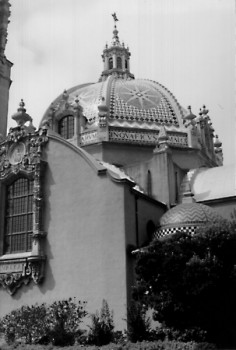 |
The California Building is along the northern side of the
entryway, and is the second stop on our tour. During the 1915 Exposition,
California as the host state decided to have its exhibition in the most
prominent location -- thus the name of the California Building. The belltower
and dome of the California Building are among the most photographed sites
in San Diego. The inscription in Latin at the base of the California Building
is a translation from Deuteronomy 8:8: "A land of wheat and barley and
vines and fig trees, a land of olive trees and honey."
While the various museums of Balboa Park serve multi-cultural audiences,
one can find a "Jewish connection" at many of them. For example, the Museum
of Man--inside the California Building--features a permanent exhibit on
life cycle events of various cultures, including the bar mitzvah ceremony
of Judaism.
From the Museum of Man, proceed east along the sidewalk toward the main
part of the park. Almost |
Dome of California Building
quotes Deuteronomy in Latin |
immediately to your left you will see the complex of buildings and stages
belonging to the Old Globe Theatre, which produces not only Shakespeare
plays which inspired its design but a full schedule of contemporary plays.Members
of the Jewish community has been stalwart supporters of the Old Globe,
particularly Bernard Lipinsky who has underwritten several seasons in memory
of his wife, Dorris.
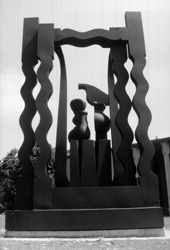  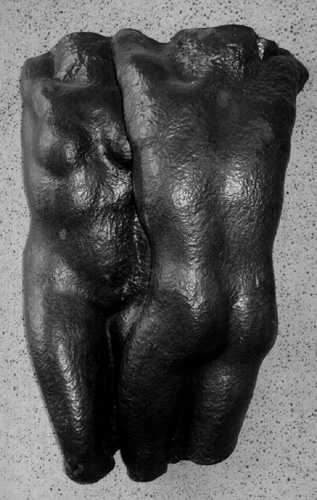 |
Further ahead are the outdoor sculpture gardens of the
San Diego Museum of Art. Here Jewish sculptors are well represented with
"Night Presence II" by Louise Nevelson; "Sonata Primitive" by Saul Baizerman
and "Odyssey" by Tony Rosenthal.
Inside the Museum of Art, itself, are paintings and drawings by such
well known Jewish artists as Marc Chagall (Nude and Vase of Flowers)
, Amedeo Modigliani (Blue Eyed Boy; Caryatid), and Camille Pissarro
(Personages and Studies of Heads) as well as a painting based on
the Book of Genesis: Francesco Maffei's Joseph Sold by His Brothers.
Over the years, the museum has addressed other Jewish subjects, including
"The Precious Legacy" exhibit featuring Judaic looted during the Holocaust
by the nazis and later housed at the state museum in the Czech Republic.
More recently the museum mounted a retrospective of the drawings and paintings
of San Diego County's own Harry Sternberg.
The San Diego Museum of Art grew out of the San Diego Fine Arts Society,
which Julius Wangenheim had helped to found. Wangenheim was one of the
San Diego citizens who militated as early as 1902 for turning the park
into a cultural treasure house.
To the south of the Museum of Art's Cafe, across the street, is the
House of Charm, where the Mingei International Museum has hosted various
traveling exhibits of Jewish interest. Among these was a long-running exhibition
of sculptures that Nikki de Saint Phalle had created for the permanent
Noah's Ark exhibit at the Jerusalem
Zoo. |
Sculptures by Louise Nevelson,
top, and Saul Baizerman, bottom |
To the east of the entrance of the Museum of Art is the Timken
Art Museum, which owns but rotates in and out of its displays a variety
of works, including Pissarro's Bords de L'Oise a Pontoise.From the
Timken Art Museum, go south a short way to a long east-west walkway lined
by buildings on both sides. At the eastern end of the walkway, you can
make out a large fountain.
Up the walkway, in the second complex of buildings to the right, is
San Diego's Museum of Photographic Arts directed by award-winning photographer
Arthur Ollman, a member of the Jewish community. MOPA has offered a variety
of shows featuring the work of Jewish photographers, including a retrospective
on Robert Capa. There is at least a minyan of Jewish photographers represented
in the museum's permanent collection, including Bruce Davidson, Neil Folberg,
Robert Frank, Lee Friedlander, John Gutmann, William Klein, Arnold Newman,
Alfred Stieglitz, Paul Strand and Roman Vishniac.
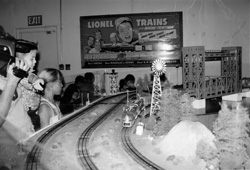 |
In the same complex is the San Diego Model Railroad Museum
where there are numerous examples of Lionel Trains, manufactured by a company
which promoted the idea that fathers and sons should spend quality time
by playing with model trains. The company's father was born Joshua Lionel
Cohen, though he later changed his surname to Cowen.
A break in the buildings on the left side of the walkway reveals the
Lilly Pond and the Botanical |
| Lionel Trains exhibit at Model RR Museum |
Building, featuring a horticultural collection from throughout the world.
Continue up the walkway to the large fountain. On the north side is the
San Diego Natural History Museum, which counted members of San Diego's
early Jewish community among its stalwart contributors. Among these especially
were the Klauber family and Samuel Fox. A large cross-section of a California
redwood has proven a wonderful way to explain to Jewish children the concept
of Tu B'Shevat, the birthday of the trees.
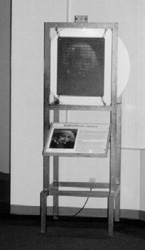 |
To the south of the fountain is the Reuben
H. Fleet Space Theatre and Science Center, whose director Jeff Kirsch
is a member of the Jewish community. It offers a variety of exhibits which
reflect both Jewish patronage of science and Jewish accomplishments. For
example, an exhibit explaining how even low resolution images can form
recognizable portraits when seen from afar proves its point with the face
of Albert Einstein.
The Nierman Challenger Learning Center made its debut Oct. 24, 1998.
The families of brothers Jim and Paul Nierman donated the mock-up of a
mission control center and 21st Century space station to introduce visitors
to space travel simulations.
Retrace your steps back down the walkway to the main plaza dominated
by the statue of El Cid atop his stallion and turn left. You |
| Einstein's low resolution |
will pass Japanese Gardens and a Teahouse, donated to San Diego by its
sister city Yokohama, en route to a large outdoor Organ Pavillion.
Because Congregation
Beth Israel is located so close to the park (at 3rd and Laurel Streets),
it has for many years made the Organ Pavilion the focus of its Simchat
Torah activities. Back in 1931, the congregation also hosted an outdoor
reception for Albert Einstein here.
  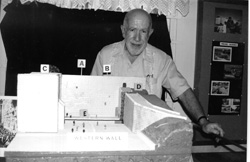 |
To the right of the Organ Pavilion and across the street
is an area known as the House of Pacific Relations. The "House" in fact
is comprised of many cottages, representing peaceful or "pacific" countries
from throughout the world. Among the nations represented is Israel. At
the House of
Israel, a small band of volunteers tends to a variety of exhibits
about Israeli geography and customs. Each Sunday, refreshments are served
to visitors from different San Diego Jewish organizations, ranging from
temple sisterhoods to the Jewish War Veterans.
Usually in April, the House of Israel sponsors a program on the outdoor
stage featuring the music and dance of Israel. Every year, the House of
Israel also participates in the International Food Fair held on the grounds.
Continue on the right side of the road, through the intersection. A
puppet theatre is on the right. Further down the right is the San Diego
Automotive Museum which includes among its exhibits the Mercedes, which
many people don't realize originally was named for Mercedes Jellinek, the
daughter of Jewish car enthusiast Emil Jellinek. Sadly, during the nazi
era, the Mercedes company forgot its Jewish roots and cooperated to the
fullest with the Third Reich.
At the end of the road is the San Diego Aerospace Museum with plenty
of exhibitry on the planes of World War II, an era so important to
Jewish history. Continue around the circle to the Starlight Theatre where
actors and musicians "freeze" the action whenever airplanes pass overhead
to the Municipal |
| House of Israel and volunteer Morris Showel |
Gymnasium. For most of 1999, the gymnasium was converted into the home
of the exhibition "World
War II Through Russian Eyes," in which the battles of the Eastern front
were recounted and artifacts seized by victorious Russian troops at the
end of the war from Hitler's bunker and from the Reich Chancellery were
displayed.
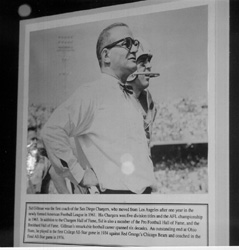 |
Continuing around the circle one comes to the San
Diego Sports Museum and Hall of Champions, whose Jewish founder, Robert
Breitbard, perhaps is one of the greatest sports fans anywhere. His memorabilia
collection includes one of the bats former San Diegan Ted Williams used
with the Boston Red Sox during his best American League season, a racket
swung by Maureen Connolly at Wimbledon, and other such artifacts. Several
Jewish athletes have been inducted into the San Diego Hall of Champions,
among them two former members of the San Diego Chargers: one time coach
Sid Gilman and one time offensive lineman Ron Mix.
At the end of the circle turn right and follow the sidewalk to the large
parking lot on the east side of |
| Sid Gilman citation at Hall of Champions |
Park Boulevard. Ahead and to the left in a building that was once
the Navy Chapel is the San Diego Veterans Memorial Center Museum. The former
chapel includes a stained glass window bearing the Magen David. Now behind
a curtain, there is a turntable altar that enabled chaplains to conduct
Catholic, Protestant or Jewish services. Sadly, in 1999, the Aron Kodesh
and Ner Tamid of the Jewish section were in need of major repairs
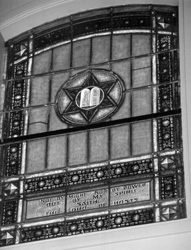 |
Memorabilia and clippings from World War II on display
at the museum focus mainly on the War in the Pacific but there are a few
exhibits touching on nazi Germany.
Several blocks up Park Boulevard, and back on the west side of the street,
is the entrance to the San
Diego Zoo. It too has its "Jewish connections." Not only does it exhibit
animals indigenous to Israel and the rest of the Middle East, but it has
acted as a "big sister" to the Biblical
Zoo in Jerusalem. Some of the exhibits at the Jerusalem facility were
modeled after the San Diego Zoo. Additionally, Jerusalem Zoo personnel
have visited the San Diego Zoo on two-week study sessions organized by
the Jerusalem
Foundation.
The "Turtletorium" at the Zoo was donated by the late Col. Irving Salomon
-- a special ambassador to the United |
| Veterans Memorial Museum window |
Nations during the administration of U.S. President Dwight D. Eisenhower.
Salomon's family also donated a large playground set on the 6th Avenue
side of Balboa Park. The colonel's daughter, Abbe Wolfsheimer Stutz, served
for eight years as a San Diego City Councilwoman.
( |